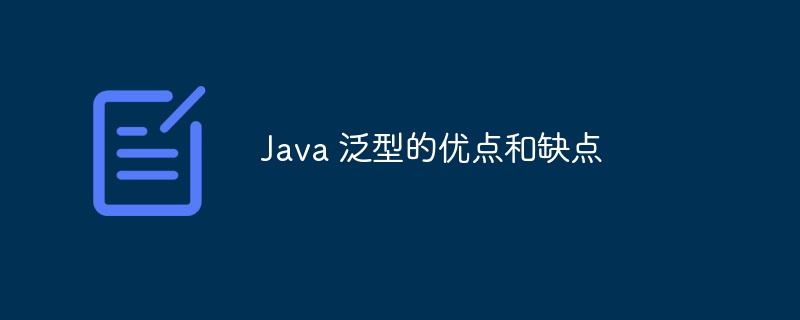1. Introduction to Java Generics
Generics are a new feature of Java 1.5. The essence of generics is a parameterized type, which means that the data type being operated is specified as a parameter. This parameter type can be used in the creation of classes, interfaces, and methods, called generic classes, generic interfaces, and generic methods respectively.
The advantage of Java generics being introduced is safety and simplicity.
Before Java SE 1.5, in the absence of generics, the "arbitrary" parameter was realized by referencing the type Object. The disadvantage of "arbitrary" was that explicit forced type conversion was required, and This conversion requires developers to know the actual parameter types beforehand. For forced type conversion errors, the compiler may not prompt an error, and an exception will occur during runtime. This is a security risk.
The advantage of generics is that type safety is checked during compilation, and all casts are automatic and implicit, improving code reuse.
There are some rules and restrictions in the use of generics:
1. The type parameters of generics can only be class types (including custom classes), not simple types.
2. The same generic type can correspond to multiple versions (because the parameter type is uncertain), and different versions of generic class instances are incompatible.
3. Generics can have multiple type parameters.
4. Generic parameter types can use the extends statement, for example. Customarily become "bounded types".
5. Generic parameter types can also be wildcard types.
Class<?> classType = Class.forName(java.lang.String);
Generics also include interfaces, methods, etc. There is a lot of content, and it takes a lot of effort to understand and apply it skillfully.
2. Java generics implementation principle: type erasure
Java’s generics are pseudo-generics. During compilation, all generic information is erased. The first prerequisite for correctly understanding the concept of generics is to understand type erasure.
Generics in Java are basically implemented at the compiler level. The type information in generics is not included in the generated Java bytecode. Type parameters added when using generics will be removed by the compiler during compilation. This process is called type erasure.
Types such as List
3. The original type retained after type erasure
The original type (raw type) is the real type of the type variable in the bytecode after the generic information has been erased. Whenever a generic type is defined, the corresponding primitive type is automatically provided. Type variables are erased (crased) and replaced with their qualified type (unqualified variables are Object).
class Pair<T> {
private T value;
public T getValue() {
return value;
}
public void setValue(T value) {
this.value = value;
}
} The original type of Pair
class Pair {
private Object value;
public Object getValue() {
return value;
}
public void setValue(Object value) {
this.value = value;
}
} Because in Pair
If the type variable is bounded, then the original type is replaced by the first bounding type variable.
For example, if Pair declares like this:
public class Pair<T extends Comparable& Serializable> {Then the original type is Comparable
Note:
If Pair declares public class Pair
To distinguish between primitive types and generic variable types
When calling a generic method, you can specify the generic type or not.
Without specifying a generic, the type of the generic variable is the lowest level of the same parent class of several types in the method, until Object.
When specifying a generic, several types in the method must be the generic instance type or its subclass.
public class Test{
public static void main(String[] args) {
/**不指定泛型的时候*/
int i=Test.add(1, 2); //这两个参数都是Integer,所以T为Integer类型
Number f=Test.add(1, 1.2);//这两个参数一个是Integer,以风格是Float,所以取同一父类的最小级,为Number
Object o=Test.add(1, "asd");//这两个参数一个是Integer,以风格是Float,所以取同一父类的最小级,为Object
/**指定泛型的时候*/
int a=Test.<Integer>add(1, 2);//指定了Integer,所以只能为Integer类型或者其子类
int b=Test.<Integer>add(1, 2.2);//编译错误,指定了Integer,不能为Float
Number c=Test.<Number>add(1, 2.2); //指定为Number,所以可以为Integer和Float
}
//这是一个简单的泛型方法
public static <T> T add(T x,T y){
return y;
}
}In fact, in a generic class, when generics are not specified, it is almost the same, except that the generic type at this time is Object, just like in ArrayList, if generics are not specified, then any type can be placed in this ArrayList Object.
4. C++ template implementation
Although I don’t understand C++, I also looked for the implementation of C++ on the Internet.
The phenomenon of generating different types for each template instantiation in C++ is called "template code bloat".
For example, vector
For more articles related to the implementation principles of Java generics, please pay attention to the PHP Chinese website!
 探讨Golang中泛型的优势和用途Apr 03, 2024 pm 02:03 PM
探讨Golang中泛型的优势和用途Apr 03, 2024 pm 02:03 PM答案:Golang泛型是提高代码可复用性、灵活性、类型安全性和可扩展性的强大工具。详细描述:优势:代码可复用性:通用算法和数据结构灵活性:运行时创建特定类型实例类型安全性:编译时类型检查可扩展性:易于扩展和自定义用途:通用函数:排序、比较等通用数据结构:列表、映射、堆栈等类型别名:简化类型声明约束泛型:确保类型安全性
 Java 泛型在 Android 开发中的应用Apr 12, 2024 pm 01:54 PM
Java 泛型在 Android 开发中的应用Apr 12, 2024 pm 01:54 PM泛型在Android开发中的应用加强了代码的可重用性、安全性和灵活性。其语法包括声明一个类型变量T,该变量可用于操作类型参数化的数据。泛型实战案例包括自定义数据适配器,允许适配器适应任何类型的自定义数据对象。Android还提供了泛型列表类(如ArrayList)和泛型方法,允许操作不同类型的参数。使用泛型的好处包括代码可重用性、安全性和灵活性,但需要注意指定正确的界限并适度使用,以确保代码的可读性。
 Java 泛型的优点和缺点Apr 12, 2024 am 11:27 AM
Java 泛型的优点和缺点Apr 12, 2024 am 11:27 AMJava泛型的优点和缺点什么是Java泛型?Java泛型允许您创建类型化的集合和类,这使得它们能够存储任何类型的对象,而不仅仅是特定类型。这提高了代码的灵活性、重用性,并减少了错误。优点类型安全:泛型在编译时强制执行类型安全,确保集合中只有兼容类型的数据,从而减少了运行时错误。重用性:泛型类和集合可以用于各种数据类型,无需重复编写代码。灵活性:泛型允许创建可灵活地处理不同类型数据的代码,提高了可扩展性和维护性。简洁的代码:泛型可以使代码更简洁、可读。API一致性:JavaCollection
 如何使用Java中的Gson库对泛型类型进行序列化和反序列化?Sep 10, 2023 am 09:17 AM
如何使用Java中的Gson库对泛型类型进行序列化和反序列化?Sep 10, 2023 am 09:17 AMIfaJavaclassisagenerictypeandweareusingitwiththeGsonlibrary forJSONserialization anddeserialization.TheGsonlibraryprovidesaclasscalledcom.google.gson.reflect.TypeTokentostoregenerictypesbycreatingaGsonTypeTokenclassandpasstheclassty
 Go语言的泛型是真泛型吗Aug 23, 2023 pm 01:56 PM
Go语言的泛型是真泛型吗Aug 23, 2023 pm 01:56 PM不是,尽管Go语言提供了一种类似于泛型的机制,但并不能被认为是真正的泛型。Go语言提供了一种称为“接口”的机制,可以用来模拟泛型的功能。尽管这种方式可以模拟泛型的功能,但并不像其他编程语言中的泛型那样灵活。在Go语言中,接口只能定义方法,而不能定义变量或属性,这意味着无法像其他编程语言中那样在接口中定义泛型的数据结构。
 Golang中接口的泛型应用解析Mar 18, 2024 pm 05:39 PM
Golang中接口的泛型应用解析Mar 18, 2024 pm 05:39 PMGolang中接口的泛型应用解析在Golang中,泛型是一个备受争议的话题。由于Golang语言本身并不直接支持泛型,开发者们在使用接口时经常会遇到一些限制和挑战。然而,在最新发布的Golang版本中,引入了对泛型的支持,使得开发者们可以更加灵活地使用接口和泛型结合的方式。本文将探讨Golang中如何使用接口和泛型相结合,并通过具体的代码示例进行解析。什么是
 go语言中泛型是什么Dec 09, 2022 pm 05:57 PM
go语言中泛型是什么Dec 09, 2022 pm 05:57 PM在go语言中,泛型就是编写模板适应所有类型,只有在具体使用时才定义具体变量类型;通过引入类型形参和类型实参的概念,让一个函数能够处理多种不同类型数据的能力,这种编程方式被称为泛型编程。


Hot AI Tools

Undresser.AI Undress
AI-powered app for creating realistic nude photos

AI Clothes Remover
Online AI tool for removing clothes from photos.

Undress AI Tool
Undress images for free

Clothoff.io
AI clothes remover

AI Hentai Generator
Generate AI Hentai for free.

Hot Article

Hot Tools

SAP NetWeaver Server Adapter for Eclipse
Integrate Eclipse with SAP NetWeaver application server.

EditPlus Chinese cracked version
Small size, syntax highlighting, does not support code prompt function

MantisBT
Mantis is an easy-to-deploy web-based defect tracking tool designed to aid in product defect tracking. It requires PHP, MySQL and a web server. Check out our demo and hosting services.

SublimeText3 Linux new version
SublimeText3 Linux latest version

PhpStorm Mac version
The latest (2018.2.1) professional PHP integrated development tool






